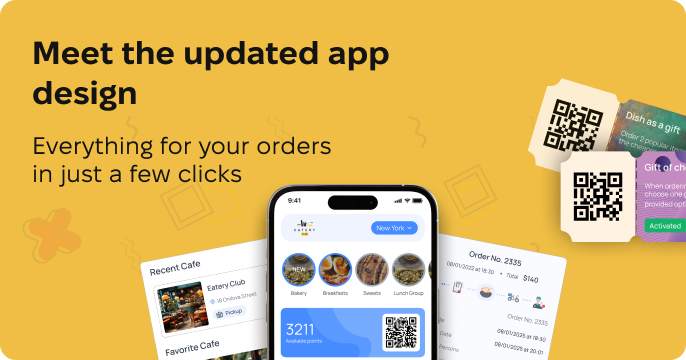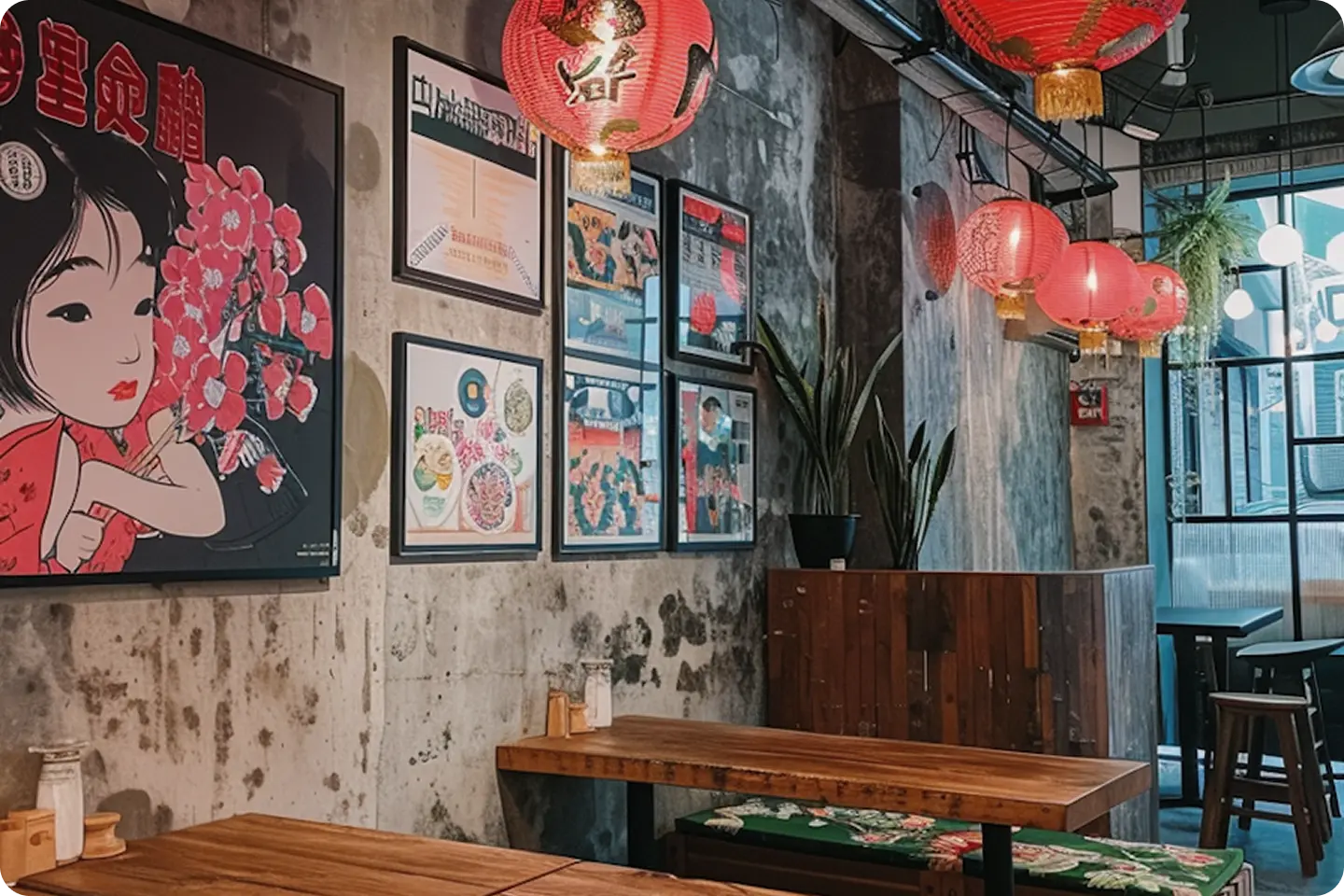Business
From delicious food to a legendary brand: how to tell the world about your restaurant
Transform your restaurant into a legendary brand with effective restaurant branding strategies. Learn how to build brand loyalty and stand out in the market.

In the bustling world of restaurants, serving delicious food is just the beginning.
To truly stand out, a restaurant must transform into a legendary brand.
This transformation involves more than just a catchy name or a stylish logo,
it requires a comprehensive brand strategy that resonates with customers.
Restaurant branding is about creating an unforgettable experience.
It’s the feeling customers get when they walk through your doors.
It’s the story you tell through your menu, decor, and service.
A strong brand can set you apart in a crowded market.
Brand storytelling is a powerful tool! It creates an emotional connection with your customers, turning them into loyal advocates. Engaging content and visuals can enhance this connection. Your staff plays a vital role too. They should embody your brand’s values and message.
In this guide, we’ll explore how to develop a brand strategy that elevates your restaurant. From defining your mission to leveraging customer feedback, we’ll cover it all. Get ready to turn your restaurant into a legendary brand.
What Is Restaurant Branding and Why Does It Matter?
Restaurant branding goes beyond aesthetics like logos and color schemes. It’s the embodiment of your restaurant’s identity and promise to customers. Successful branding creates a consistent customer experience that differentiates you from competitors.
Think of branding as the personality of your restaurant. It’s how you express your values, mission, and vision to the world. This identity should resonate throughout every aspect of your business, from visuals to customer interactions.
Key Elements of Restaurant Branding:
- Logo and Color Scheme: Visual representation of your brand.
- Brand Story: The narrative that connects emotionally with your audience.
- Customer Experience: The ambiance and service that define visits.
- Consistency: Uniformity in messaging across all platforms.
A strong brand strategy can transform how customers perceive your restaurant. Branding fosters trust and encourages repeat visits by creating loyalty. People love to identify with brands that reflect their lifestyle and values.
A well-executed branding strategy also gives you a competitive advantage. It helps your restaurant stand out in a saturated market. Moreover, it can command premium pricing as customers are willing to pay for a trusted, high-quality experience.
Ultimately, restaurant branding is an investment in your business’s long-term success. By nurturing a memorable brand, you create a legacy that customers remember and cherish. This makes them more likely to recommend your restaurant to others.
The Foundations: Defining Your Mission, Vision, and Values
Every successful restaurant brand begins with a clear mission, vision, and values. These foundational elements guide your brand’s direction and inform every decision.
Your mission statement should articulate your restaurant’s purpose. It explains why your restaurant exists and what you aim to achieve. Keep it concise but meaningful to resonate with your audience.
A compelling vision statement paints a picture of the future. It describes the ultimate goal your restaurant aspires to reach. This long-term target should be ambitious yet achievable with focused efforts.
Establishing Core Values:
- Integrity: Build trust with transparent practices.
- Quality: Maintain high standards in food and service.
- Community: Foster connections and give back locally.
- Innovation: Embrace creativity and forward-thinking.
Understanding Your Audience and Market Position
To effectively brand your restaurant, it’s vital to understand your audience and market position.
Start by identifying the demographics of your ideal customers. Consider factors such as age, income, lifestyle, and dining preferences. This helps tailor your brand message to attract the right audience.
Research your competition to establish your market position. Identify what makes your restaurant different and better. Use this competitive analysis to highlight your strengths and unique offerings. Understanding customer needs allows you to address them more effectively. Conduct surveys or focus groups to gain deeper insights into what your patrons value. Feedback from these methods can guide your branding efforts.
Craft your brand message to appeal to both your current and potential customers. Align this message with their needs and desires to create a connection. This alignment often leads to higher engagement and brand loyalty.
Accurate audience understanding helps refine your marketing strategies. It ensures your restaurant’s branding resonates with the right people and enhances your market standing. Proper audience insights will empower your brand to thrive.
Crafting a Unique Brand Identity: Name, Logo, and Visual Elements
A restaurant’s brand identity is its distinguishing mark in the culinary world. It begins with a memorable name. Your restaurant’s name should reflect its essence and be easy to remember. The name sets the stage for your restaurant’s story and values.
Creating a captivating logo is the next step. A logo functions as your visual identifier. It should be simple yet impactful, aligning with your brand’s personality. Choose shapes and symbols that represent your restaurant’s theme and appeal.
Color plays a crucial role in visual branding. A carefully selected color scheme sets the mood and complements your brand identity. Vibrant colors may energize, while softer tones can create a calming atmosphere.
Typography is another critical aspect. The font style used in your branding should be legible and consistent across all materials. It should evoke the desired emotional response from your audience.
Photographs and images support your brand identity. Use visuals that tell your restaurant’s story and resonate with your audience. High-quality images enhance brand perception and help connect with customers on a deeper level.
Consistency in visual elements is paramount. All elements should form a cohesive look. This builds recognition and strengthens your brand’s presence, both offline and online. A strong brand identity is a powerful tool in creating a restaurant that stands out.
Developing Your Brand Voice and Storytelling
A compelling brand voice sets your restaurant apart. It shapes how you communicate with your audience. Your brand voice should reflect the personality and values of your restaurant.
To define your brand voice, consider your desired image. Are you aiming for a casual, fun vibe, or an upscale, refined tone? Your choice impacts all written and spoken communications with customers.
Storytelling is a vital component of branding. It creates a connection with your audience. Your brand story should express your restaurant’s journey, mission, and what makes it unique. A good story captivates and engages customers, encouraging loyalty.
Essentials of Brand Storytelling:
- Authenticity: Share genuine experiences.
- Emotion: Evoke feelings and foster connection.
- Consistency: Maintain the same voice across platforms.
Use storytelling to showcase what you stand for. Share the inspiration behind your dishes or the passion of your team. Craft narratives that align with the emotions and values you wish to convey.
Incorporate your brand story into all customer interactions. From social media posts to menu descriptions, your storytelling should be an ever-present element. These stories create an emotional connection that transforms visitors into loyal patrons. Your voice and narratives help shape a memorable restaurant experience.
Designing the Guest Experience: Ambiance, Menu, Service
The guest experience is a cornerstone of restaurant branding. Every detail contributes to how your brand is perceived. A cohesive experience can turn a single visit into a lasting memory.
The ambiance should mirror your brand’s identity. Elements like lighting, music, and decor work together to create the desired atmosphere. They help convey the essence of your restaurant’s theme and vibe.
Consider how color schemes influence emotions. A vibrant, energetic setting might suit a lively bistro, while soft tones might fit a sophisticated dining spot. Everything from table arrangements to art on the walls plays a part.
Your menu is more than a list of dishes. It’s a canvas to express creativity and reinforce your brand’s story. Choose fonts, imagery, and descriptions that align with your brand’s style.
Use menu storytelling to highlight special ingredients or the history behind certain dishes. This strengthens the connection between your brand’s tale and the culinary experience.
Invest in high-quality, “juicy” photos. Show not only the finished dish but also the cooking process and fresh ingredients.
Service is a direct extension of your brand. Staff interactions shape perceptions of professionalism and hospitality. Train employees to embody your brand values in every guest interaction.
Consistency in service enhances brand reliability. Predictable and attentive service reassures guests that they can expect the same experience every visit.
Attention to detail in ambiance, menu design, and service creates a holistic guest experience. These elements unify to tell your brand’s story and shape every customer’s perception of your restaurant.
Building a Consistent Brand Across All Touchpoints
Brand consistency is crucial for recognition and trust. Every customer interaction, whether online or offline, should reflect your brand’s core values. This requires a unified approach across all touchpoints.
Start by reviewing all brand collateral. Are your visuals and messaging coherent on your website, social media, and physical space? Inconsistencies can dilute your brand message and confuse customers.
Ensure that your team communicates the same brand message. This includes how staff answers phones, respond to emails, and engage with clients in person. Consistent communication reinforces your brand identity.
Essential Touchpoints for Brand Consistency:
- Visuals: Logo, color scheme, and design elements.
- Communication: Tone of voice and messaging.
- Customer Interactions: Both online and offline experiences.
A consistent brand presence builds customer trust and loyalty. When all brand touchpoints align, it strengthens your brand’s market position. This cohesion tells customers they can rely on your restaurant for a dependable experience each time they visit.
Digital Branding: Website, Social Media, and Online Presence
In today’s digital world, a strong online presence is vital for restaurant branding. Your website, mobile app and social media profiles act as the face of your brand online. They should communicate your brand’s personality and values effectively.
Your website is more than just a menu display. It’s a platform to tell your story and showcase what makes your restaurant unique. Ensure it is user-friendly, mobile-responsive, and reflects your restaurant’s ambiance and theme.
Invest in high-quality, “juicy” photos for your website and mobile app. Show not only the finished dish but also the cooking process and fresh ingredients. Create short videos that convey the atmosphere and aroma.
Make sure you’re easy to find
- Be on the Map: Register your establishment on Google and other popular map services. Check that all information is up-to-date: address, hours of operation, phone number. This is the very first and most crucial step to help customers find their way to you.
- Create Your Pages: Social media platforms like Instagram, Facebook, TikTok, X are powerful branding tools. They allow for direct engagement with your audience. Use these channels to share updates, engage with customers, and visually convey your brand’s essence.
Embrace Technology
Make your guests’ experience even better:
- QR menu: Quick and hygienic access to the menu right from a smartphone.
- Self-service kiosk: Reduce the load on staff during peak hours and increase the average check with upselling recommendations.
- Push notifications: Instantly inform customers about promotions, order statuses, or new items.
Your online presence should be an extension of your in-restaurant experience. Be consistent in voice and visuals across all platforms. This cohesion helps reinforce your brand’s identity, making it more memorable to customers. A strong digital brand can drive not only online traffic but also more foot traffic to your restaurant.
Leveraging Customer Feedback and Community Engagement
Customer feedback is a goldmine for refining your restaurant branding. It offers insights into what works and what needs improvement. Encouraging reviews helps you understand customer perceptions and adjust your brand strategy.
Actively engaging with your community builds trust and loyalty. Host local events or collaborate with nearby businesses. These efforts not only boost visibility but also tie your brand to community values.
Online reviews should never be ignored. Respond to both positive and negative feedback to show that you value customer opinions. This interaction can transform occasional visitors into loyal customers.
Ways to Engage with Your Community:
- Host Events: Organize charity drives or local music nights.
- Collaborations: Partner with local artisans or businesses.
- Feedback Integration: Use surveys within your restaurant mobile apps for direct input.
These strategies ensure your restaurant is not just a place to eat, but a vital part of the community. This active participation strengthens your brand and fosters a deeper connection with customers. Building a community-focused image can enhance brand loyalty significantly.
Training Your Team to Live the Brand
Your team plays a crucial role in your restaurant branding. Their actions and attitudes greatly influence customer perceptions. Proper training ensures they embody the brand’s values.
Start with a comprehensive onboarding program. Introduce new hires to your brand’s mission and vision. This builds a solid foundation for their role in your brand strategy.
Regular training sessions keep brand values fresh in employees’ minds. These sessions should focus on customer interaction and service delivery. A well-trained team provides a consistent brand experience, enhancing customer trust.
Key Training Focus Areas:
- Brand Values: Deepen understanding of brand identity.
- Customer Service: Enhance interaction skills and service quality.
- Feedback Process: Empower staff to handle reviews positively.
By investing in your team’s development, you strengthen your brand’s identity. A unified team fosters a positive, memorable customer experience. This commitment to training can transform staff into brand ambassadors, elevating your restaurant’s reputation.
Brand Development Strategies for Growth and Loyalty
Strategic brand development is key to long-term success. It requires a nuanced approach that reflects your restaurant’s unique attributes. Start by identifying areas where your brand can differentiate itself.
Focus on building relationships with your audience. Engaging customers creates loyalty, which is vital for growth. Develop programs that reward repeat visits, ensuring your patrons feel valued.
Turn one-time visitors into regulars. What you can implement:
- Cashback and bonuses: Reward every order.
- Loyalty tiers: “Regular Guest,” “VIP Client” — offer privileges for dedication.
- Gifts: Automatically wish them a happy birthday, and offer bonuses for registering in the app.
Your value proposition should highlight what sets you apart. Whether it’s a special dish or exceptional service, make it a focal point of your branding efforts. This clarity strengthens customer loyalty and attracts new diners.
Investing in community involvement can elevate your brand, too. Partner with local organizations to broaden your brand’s reach and reinforce your commitment to the community. Building a strong community connection boosts brand loyalty and word-of-mouth referrals.
Adapting to industry trends and customer feedback keeps your brand relevant. Regularly review and refine your strategies, ensuring alignment with market demands. Continuous evolution reinforces your brand’s position and paves the way for sustained growth.
Measuring Success: Brand Audits and Adapting to Change
Regular brand audits are essential to assess your brand’s effectiveness. They help identify strengths and areas needing improvement. This proactive approach ensures your brand remains compelling and competitive.
Start by evaluating customer feedback and engagement metrics. Pay attention to online reviews, social media interactions, and sales trends. These insights reveal how your brand is perceived and where adjustments may be necessary.
Embrace change and be willing to adapt. The restaurant industry evolves rapidly, and staying relevant requires agility. Implement innovative strategies that align with emerging trends and customer expectations.
Balancing consistency with adaptability strengthens your brand. It assures customers of your reliability while showcasing your responsiveness. By continuously auditing and refining your brand, you ensure a lasting, positive impact in the market.
Turning Your Restaurant into a Legendary Brand
Remember, strong branding turns customers into advocates, ensuring your restaurant becomes not just a place to eat but a memorable and favored destination.






